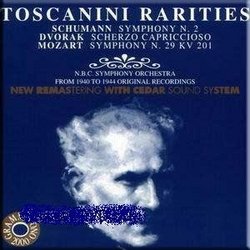| All Artists: Toscanini, Dvorak, Schumann, Mozart Title: Toscanini Rarities Members Wishing: 0 Total Copies: 0 Label: Grammofono 2000 Release Date: 5/23/1995 Genre: Classical Styles: Historical Periods, Classical (c.1770-1830), Symphonies Number of Discs: 1 SwapaCD Credits: 1 UPCs: 723722079924, 8011662903563 |
Search - Toscanini, Dvorak, Schumann :: Toscanini Rarities
 | Toscanini, Dvorak, Schumann Toscanini Rarities Genre: Classical
|
Larger Image |
CD Details |
CD ReviewsOne of the Greatest Schumann Seconds of All Time! 09/16/1998 (4 out of 5 stars) "This NBC Symphony performance from the live concert of March 29, 1941, preserves an event from one of the finest seasons of the NBC organization (some would say the BEST season of the 17 years that Toscanini led the ensemble.) The Maestro was but a "young" man -- a mere 74! -- and conducts with all the vigor and passion of inflamed youth. The orchestral members catch fire, and pour forth a Schumann C Major that is alive with strength, masculinity, and intensity, while never sacrificing lyricism for mere force or drama. When Toscanini revisited the piece in 1946 (as evidenced by a fine Dell'Arte CD transfer) his viewpoint was slightly detached and magisterial, lacking the elemental energy of the pre-war rendition.One surmises that the source material of the 1941 program was an early FM radio aircheck disk recording, done on professional gear at 33.3 rpm. There are highs extending up to about 9 kHz: the burr and rasp of the brass is captured very clearly and bitingly, and there is full bass response, which helps moderate the dry quality of Studio 8-H sound (here, but not on original disks, "aided" by extra modern electronic echo.) The reason I suspect that this is an off-air FM recording and NOT an archival in-house 8-H transcription is the rather awful peak limiting that occurs at loud passages involving brilliant high frequencies: note the bright trumpet parts soaring above the orchestra in full cry at about 10:30 - 10:35 elapsed time on Track #1. The trumpet sounds (especially its brilliant overtones) are clearly causing a "ducking effect" of a peak limiter (audible also on the original Clyde Key / Toscanini Society private LP issue of the early seventies.) This 'burping' sound is NEVER noticeable on first-generation in-house RCA disks, as released on the BMG series, the WRVR rebroadcasts, or the best of the Clyde Key / Toscanini Society LP recordings of post-war broadcasts. I would guess that this MAY be a live 1941 "simulcast" on RCA's experimental FM station W2XMN, as taken down at home by a certain professional radio engineer who lived in the New York area, and whose voluminous transcription collection sourced many of the Clyde Key society LP issues. This technical limiting artifact is really the only shortcoming of the recording: even the extra phony echo added by Grammophono does not totally wreck one's pleasure in the performance (as happens in some other of their issues, as well as Iron Needle's frequent travesties.) The original source recording of the April, 1940 broadcast of the Dvorak Scherzo Capriccioso sounds like a good-quality AM radio aircheck disk. The highs cut off at about 5 kHz, but all in all, the sound is typical of commercial 78s of the period. Toscanini is especially relaxed here, and does not push the tempi as he does in his commercial recordings of other Czech pieces (such as the Moldau and New World Symphony.) The reading reminds me very much of the very affectionate old Neumann/Czech Philharmonic stereo LP of the early sixties, or even of some of the finest of the Talich renditions of Dvorak. Play this track "anonymously" for a Toscanini hater and have her guess who the conductor might be. Most prejudiced anti-Toscaninians think that the Italian maestro conducted everything at breakneck tempo and with clipped phrasing: here all is soulful expression combined with moderate pacing.The Mozart Symphony No. 29 is NOT a great performance: taken down at a broadcast of Sept. 1943, the sound is pieced together from several different disk sources with varying high frequency content and distortion components, and is mostly wiry and thin (as were the "bootleg" tapes that have circulated among collectors); the opening of the symphony is played clumsily and tentatively; there are no repeats in the sixteen and a half minutes' duration of the reading; and the gallantry of the music is given short shrift in the attempt at celerity and virtuosity. Yet certain lyrical passages are played with too much legato and sustenuto, in phrasing that seems mannered and old-fashioned (rather like Pablo Casals' conducting of Mozart on many Columbia LPs and CDs of live Marlboro Festival performances.) There are innumerable later performances to be preferred (such as the speedy but expressive Bruno Walter rendering of 1954 in the Sony Bruno Walter Edition CD series) but few earlier ones: the Beecham shellac recordings predating this Toscanini broadcast were not well received by the critics in comparison to his towering interpretations of the G Minor and other Mozart symphonies. But if one desires a modern transfer of this particular Toscanini broadcast (which, one admits, does contain a nice and effective Andante movement, displaying Toscanini's concentration on the lyrical line), this Grammophono production is vastly superior to the wretched caricature on Iron Needle."
|

 Track Listings (9) - Disc #1
Track Listings (9) - Disc #1